engine RENAULT WIND 2012 1.G User Guide
[x] Cancel search | Manufacturer: RENAULT, Model Year: 2012, Model line: WIND, Model: RENAULT WIND 2012 1.GPages: 185, PDF Size: 5.52 MB
Page 54 of 185
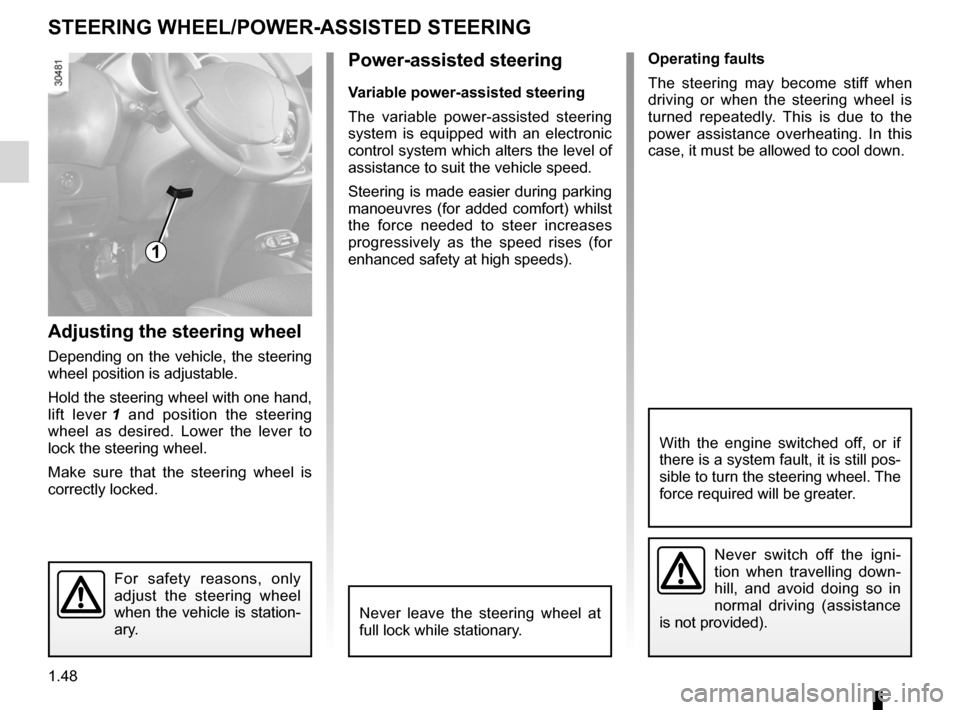
steering wheeladjustment ...................................... (up to the end of the DU)
power-assisted steering ........................(up to the end of the DU)
power-assisted steering ........................(up to the end of the DU)
1.48
ENG_UD11167_1
Volant de direction (E33 - X33 - Renault)
ENG_NU_865-6_E33_Renault_1
Operating faults
The steering may become stiff when
driving or when the steering wheel is
turned repeatedly. This is due to the
power assistance overheating. In this
case, it must be allowed to cool down.power-assisted steering
Variable power-assisted steering
The variable power-assisted steering
system is equipped with an electronic
control system which alters the level of
assistance to suit the vehicle speed.
Steering is made easier during parking
manoeuvres (for added comfort) whilst
the force needed to steer increases
progressively as the speed rises (for
enhanced safety at high speeds).
Steering wheel
Power-assisted steering
STEERING WHEEL/pOWER-ASSISTED STEERING
Never leave the steering wheel at
full lock while stationary.
Never switch off the igni -
tion when travelling down -
hill, and avoid doing so in
normal driving (assistance
is not provided).
With the engine switched off, or if
there is a system fault, it is still pos-
sible to turn the steering wheel. The
force required will be greater.
Adjusting the steering wheel
Depending on the vehicle, the steering
wheel position is adjustable.
Hold the steering wheel with one hand,
lift lever 1 and position the steering
wheel as desired. Lower the lever to
lock the steering wheel.
Make sure that the steering wheel is
correctly locked.
For safety reasons, only
adjust the steering wheel
when the vehicle is station-
ary.
1
Page 58 of 185
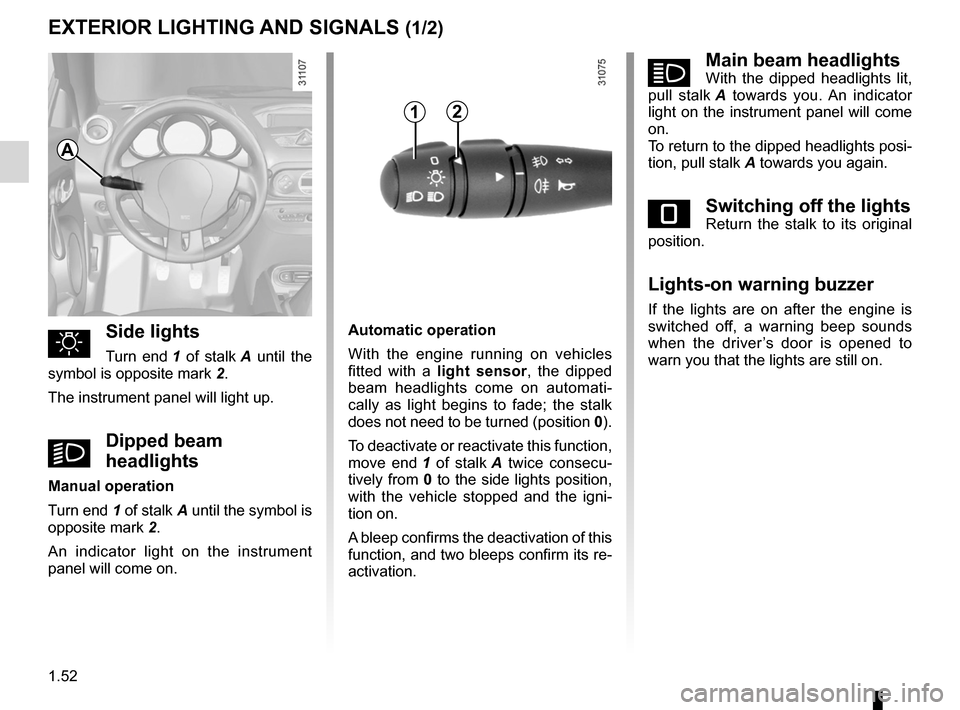
lighting:exterior ............................................ (up to the end of the DU)
instrument panel .................................................... (current page)
lights: side lights ......................................................... (current page)
lights: dipped beam headlights ................................... (current page)
hazard warning lights signal .................................. (current page)
signals and lights .................................. (up to the end of the DU)
lighting: instrument panel .............................................. (current page)
daytime running lights ............................................ (current page)
1.52
ENG_UD21753_2
Éclairages et signalisations extérieurs (E33 - X33 - Renault)
ENG_NU_865-6_E33_Renault_1
Jaune NoirNoir texte
áMain beam headlightsWith the dipped headlights lit,
pull stalk A towards you. An indicator
light on the instrument panel will come
on.
To return to the dipped headlights posi-
tion, pull stalk A towards you again.
eSwitching off the lightsReturn the stalk to its original
position.
Lights-on warning buzzer
If the lights are on after the engine is
switched off, a warning beep sounds
when the driver ’s door is opened to
warn you that the lights are still on.
Exterior lighting and signals
EXTERIOR LIGHTING AND SIGNALS (1/2)
uSide lights
Turn end 1 of stalk A until the
symbol is opposite mark 2.
The instrument panel will light up.
kDipped beam
headlights
Manual operation
Turn end 1 of stalk A until the symbol is
opposite mark 2.
An indicator light on the instrument
panel will come on.
A
Automatic operation
With the engine running on vehicles
fitted with a light sensor , the dipped
beam headlights come on automati -
cally as light begins to fade; the stalk
does not need to be turned (position 0).
To deactivate or reactivate this function,
move end 1 of stalk A twice consecu -
tively from 0 to the side lights position,
with the vehicle stopped and the igni -
tion on.
A bleep confirms the deactivation of this
function, and two bleeps confirm its re-
activation.
21
Page 60 of 185

wipers ................................................... (up to the end of the DU)
windscreen washer/wiper ..................... (up to the end of the DU)
windscreen washer ............................... (up to the end of the DU)
1.54
ENG_UD25520_2
Essuie-vitre / lave-vitre avant (E33 - X33 - Renault)
ENG_NU_865-6_E33_Renault_1
Jaune NoirNoir texte
Windscreen washers/wipers
SCREEN WASHER/WIpER (1/2)
nWindscreen wiper
With the ignition on, move
stalk 1:
A park
B intermittent wiping
The wipers will pause for sev -
eral seconds between sweeps.
Depending on the vehicle, it is pos-
sible to change the time between
sweeps by turning ring 2.
C normal wiping speed
D fast wiping speed
Special note
When driving every time the vehi -
cle stops, the wipers slow down, e.g.
fast wiping speed is reduced to normal
wiping speed.
As soon as the vehicle moves off,
wiping will return to the speed originally
selected.
Any action on stalk 1 overrides and
cancels automatic operation.
Vehicles with automatic wiper
function
With the engine running, move
stalk 1:
A park
B automatic wiper function
When this position is selected, the
system detects the presence of
water on the windscreen and triggers
wiping at a suitable wiping speed. It
is possible to change the time be -
tween sweeps by turning ring 2.
C normal wiping speed
D fast wiping speed
With the vehicle stationary, if for
any reason the wipers cannot move
(e.g. stuck to windscreen by ice),
the system will automatically cut off
the power supply to the wipers.
2
A
B
C
D
1
1
Page 61 of 185
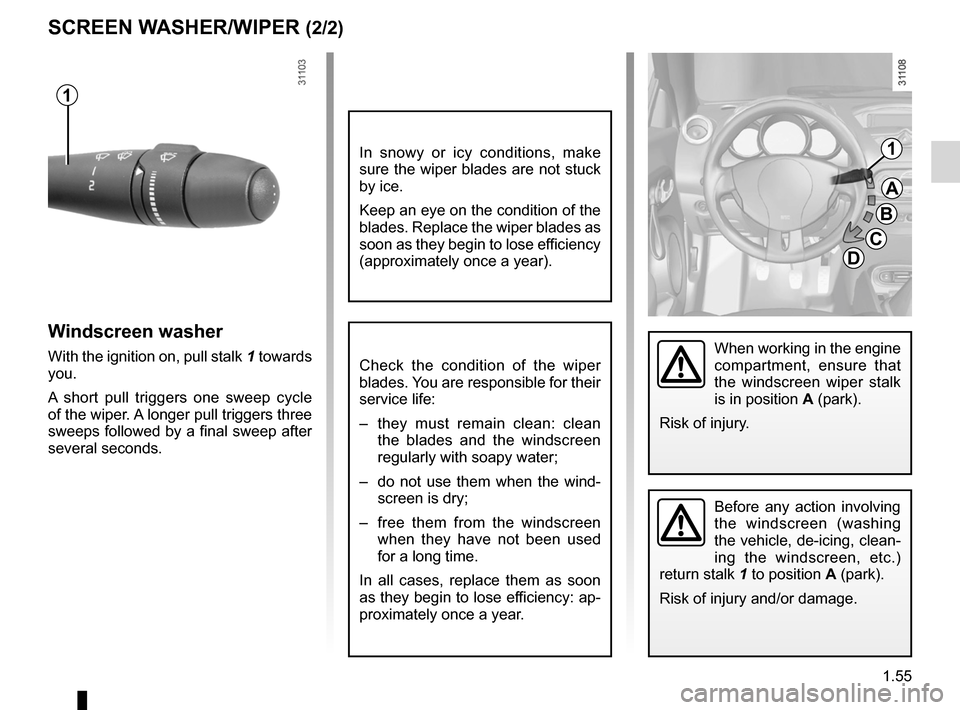
JauneNoirNoir texte
1.55
ENG_UD25520_2
Essuie-vitre / lave-vitre avant (E33 - X33 - Renault)
ENG_NU_865-6_E33_Renault_1
Before any action involving
the windscreen (washing
the vehicle, de-icing, clean -
ing the windscreen, etc.)
return stalk 1 to position A (park).
Risk of injury and/or damage.
SCREEN WASHER/WIpER (2/2)
When working in the engine
compartment, ensure that
the windscreen wiper stalk
is in position A (park).
Risk of injury.Windscreen washer
With the ignition on, pull stalk 1 towards
you.
A short pull triggers one sweep cycle
of the wiper. A longer pull triggers three
sweeps followed by a final sweep after
several seconds.
A
B
C
D
1
Check the condition of the wiper
blades. You are responsible for their
service life:
– they must remain clean: clean
the blades and the windscreen
regularly with soapy water;
– do not use them when the wind-
screen is dry;
– free them from the windscreen
when they have not been used
for a long time.
In all cases, replace them as soon
as they begin to lose efficiency: ap-
proximately once a year.
In snowy or icy conditions, make
sure the wiper blades are not stuck
by ice.
Keep an eye on the condition of the
blades. Replace the wiper blades as
soon as they begin to lose efficiency
(approximately once a year).
1
Page 62 of 185

fuel tank capacity .................................. (up to the end of the DU)
fuel filling ................................................ (up to the end of the DU)
fuel grade ............................................... (up to the end of the DU)
fuel tank capacity ........................................... (up to the end of the DU)
fuel capacity ............................................................ (current page)
fuel filler cap ......................................... (up to the end of the DU)
1.56
ENG_UD24355_2
Réservoir à carburant (E33 - X33 - Renault)
ENG_NU_865-6_E33_Renault_1
Jaune NoirNoir texte
Fuel tank (filling with fuel)
FUEL TANK (1/2)
Capacity of the fuel tank: 40 litres ap-
proximately.
To open the compartment, place your
finger into recess 2, then pull the cover.
For details on filling the fuel tank, refer
to the information on “Filling with fuel”
on the next page.
Cap holder 1 is provided on the fuel
filler flap for holding the cap when the
tank is being filled.
1
A
Fuel grade
Use a high grade fuel with the appro-
priate octane rating as defined by the
particular standards in force in your
country.
It is essential to use unleaded petrol.
The octane rating (RON) must con -
form with the specifications given on
the label inside fuel filler flap A . Refer
to the information on “Engine specifica-
tions” in Section 6.
Fuel filler cap: this is spe-
cific to the vehicle type. If
you have to replace it, make
sure the new cap is of the
same type. Contact an approved
Dealer.
Never place the cap near a source
of heat or flame.
Do not wash the filler area with a
high-pressure washer.
Filling with fuel
Using leaded petrol will damage the
antipollution system and may lead to a
loss of warranty.
To ensure the fuel tank is not filled
with leaded petrol, the fuel tank filler
neck contains a restrictor fitted with a
valve which only allows the nozzle
for unleaded petrol to be used (at the
pump).
– Insert the nozzle as far as it will go
so that the valve is opened.
– Keep the nozzle in this position
throughout the entire filling opera -
tion.
When the pump cuts out automatically
at the end of the filling procedure, a
maximum of two further filling attempts
may be made, as there must be suffi -
cient space in the fuel tank to allow for
expansion.
2
After filling, check that the cap and
cover are closed.
Page 63 of 185
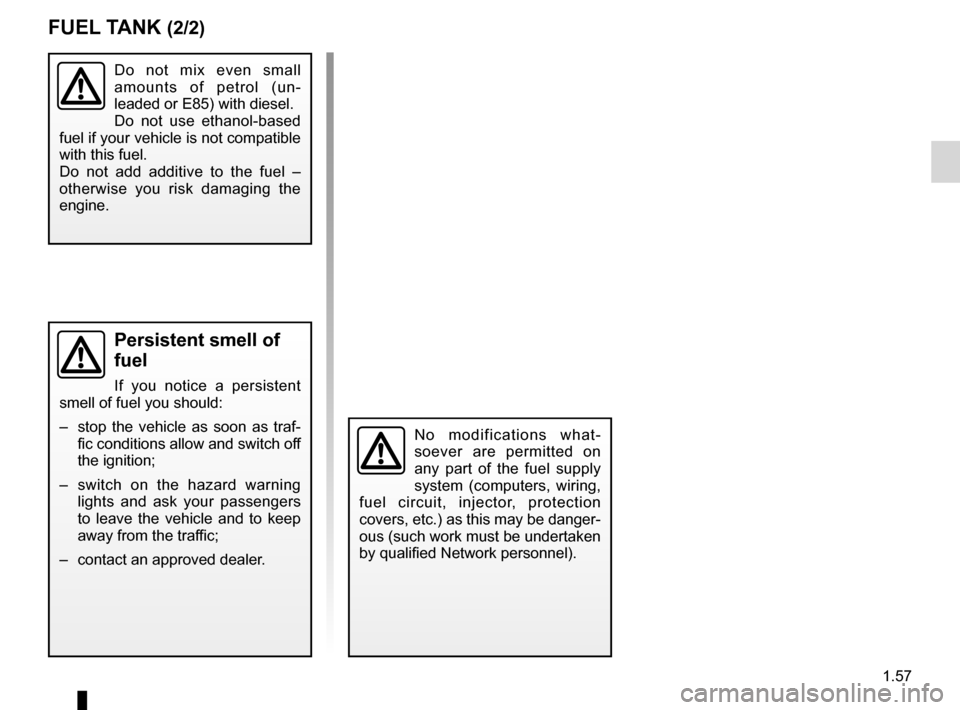
JauneNoirNoir texte
1.57
ENG_UD24355_2
Réservoir à carburant (E33 - X33 - Renault)
ENG_NU_865-6_E33_Renault_1
No modifications what -
soever are permitted on
any part of the fuel supply
system (computers, wiring,
fuel circuit, injector, protection
covers, etc.) as this may be danger-
ous (such work must be undertaken
by qualified Network personnel).
FUEL TANK (2/2)
persistent smell of
fuel
If you notice a persistent
smell of fuel you should:
– stop the vehicle as soon as traf-
fic conditions allow and switch off
the ignition;
– switch on the hazard warning
lights and ask your passengers
to leave the vehicle and to keep
away from the traffic;
– contact an approved dealer.
Do not mix even small
amounts of petrol (un -
leaded or E85) with diesel.
Do not use ethanol-based
fuel if your vehicle is not compatible
with this fuel.
Do not add additive to the fuel –
otherwise you risk damaging the
engine.
Page 65 of 185
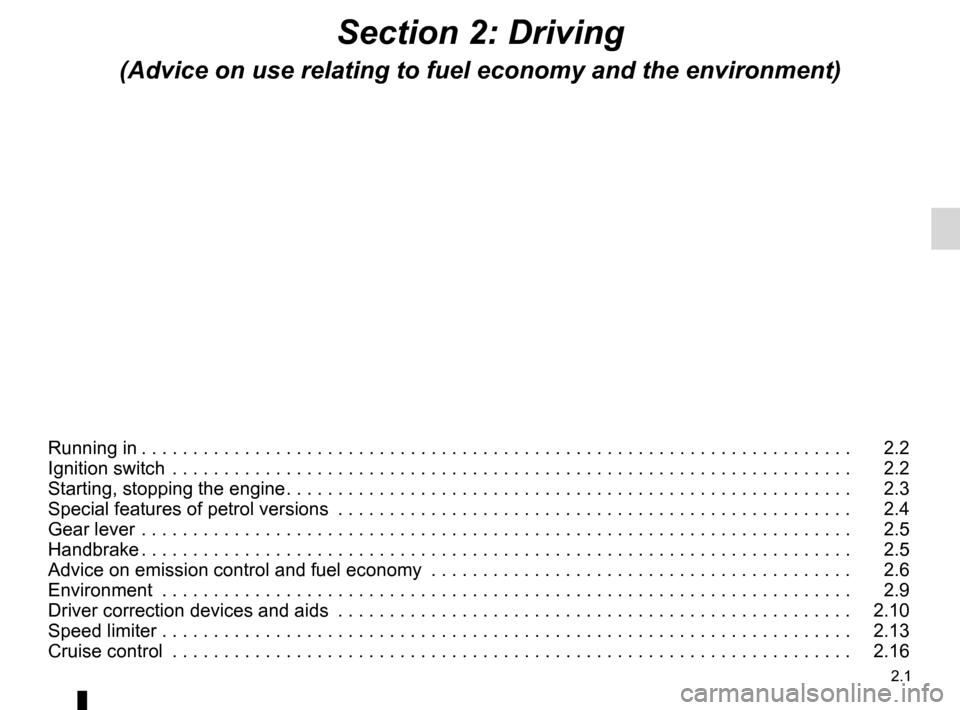
2.1
ENG_UD29994_7
Sommaire 2 (E33 - X33 - Renault)
ENG_NU_865-6_E33_Renault_2
Section 2: Driving
(Advice on use relating to fuel economy and the environment)
Running in . . . . . . . . . . . . . . . . . . . . . . . . . . . . . . . . . . . . . . . . . . . . . . . . . . . . . . . . . . . . . . . . . . . . . 2.2
Ignition switch . . . . . . . . . . . . . . . . . . . . . . . . . . . . . . . . . . . . . . . . . . . . . . . . . . . . . . . . . . . . . . . . . . 2.2
Starting, stopping the engine . . . . . . . . . . . . . . . . . . . . . . . . . . . . . . . . . . . . . . . . . . . . . . . . . . . . . . . 2.3
Special features of petrol versions . . . . . . . . . . . . . . . . . . . . . . . . . . . . . . . . . . . . . . . . . . . . . . . . . . 2.4
Gear lever . . . . . . . . . . . . . . . . . . . . . . . . . . . . . . . . . . . . . . . . . . . . . . . . . . . . . . . . . . . . . . . . . . . . . 2.5
Handbrake . . . . . . . . . . . . . . . . . . . . . . . . . . . . . . . . . . . . . . . . . . . . . . . . . . . . . . . . . . . . . . . . . . . . . 2.5
Advice on emission control and fuel economy . . . . . . . . . . . . . . . . . . . . . . . . . . . . . . . . . . . . . . . . . 2.6
Environment . . . . . . . . . . . . . . . . . . . . . . . . . . . . . . . . . . . . . . . . . . . . . . . . . . . . . . . . . . . . . . . . . . . 2.9
Driver correction devices and aids . . . . . . . . . . . . . . . . . . . . . . . . . . . . . . . . . . . . . . . . . . . . . . . . . . 2.10
Speed limiter . . . . . . . . . . . . . . . . . . . . . . . . . . . . . . . . . . . . . . . . . . . . . . . . . . . . . . . . . . . . . . . . . . . 2.13
Cruise control . . . . . . . . . . . . . . . . . . . . . . . . . . . . . . . . . . . . . . . . . . . . . . . . . . . . . . . . . . . . . . . . . . 2.16
Page 66 of 185

running in .............................................. (up to the end of the DU)
driving ................................................... (up to the end of the DU)
ignition switch ....................................... (up to the end of the DU)
2.2
ENG_UD25521_3
Rodage (E33 - X33 - Renault)
ENG_NU_865-6_E33_Renault_2
Running in
Ignition switch
Up to 600 miles (1,000 km) , do not
exceed 78 mph (130 km/h) in top gear
or 3,000 to 3,500 rpm.
You may only expect top performance
from your vehicle after approximately
1,800 miles (3 000 km).
Service intervals: please refer to your
vehicle’s Maintenance Document.
RUNNING IN/IGNItIoN SwItch
“off and steering locked” position
St
To lock: remove the key and turn the
steering wheel until the steering column
locks.
To unlock: turn the key and the steering
wheel slightly.
“Accessories” position A
When the ignition is switched off, any
accessories (radio, etc.) will continue to
function. “Ignition” position M
The ignition is on and the engine can
be started.
“Start” position D
If the engine fails to start at the first at-
tempt, turn the key back before activat-
ing the starter again. Release the key
as soon as the engine starts.
Page 67 of 185

starting the engine ................................ (up to the end of the DU)
starting the engine ................................ (up to the end of the DU)
2.3
ENG_UD29995_3
Démarrage / Arrêt moteur avec carte RENAULT mains libres (E33 - X33 - Renault)
ENG_NU_865-6_E33_Renault_2
Starting, stopping the engine
St ARtING/StoPPING thE ENGINE
Starting the engine
Engine warm or cold:
– Turn the ignition key to “Start” posi-
tion D without accelerating;
– release the key as soon as the
engine starts.
Special note: if starting the engine
when the outdoor temperature is very
low (below - 10 ° C): hold down the
clutch pedal until the engine starts.
Stopping the engine
With the engine idling, turn the key
back to “Stop” position St.
Driver’s responsibility
Never leave your vehicle
with the key or remote con-
trol inside the vehicle and
never leave a child (or a pet) unsu-
pervised, even for a short while.
There is a risk that they could start
the engine or operate electrical
equipment (electric windows etc.)
and trap part of their body (neck,
arms, hands, etc.).
Risk of serious injury.
Never switch off the ignition
before the vehicle has stopped
completely . Once the engine has
stopped, the brake servo, pow -
erassisted steering, etc., and the
passive safety devices such as
air bags and pretensioners will no
longer operate.
The steering is locked when the key
is removed.
Page 68 of 185
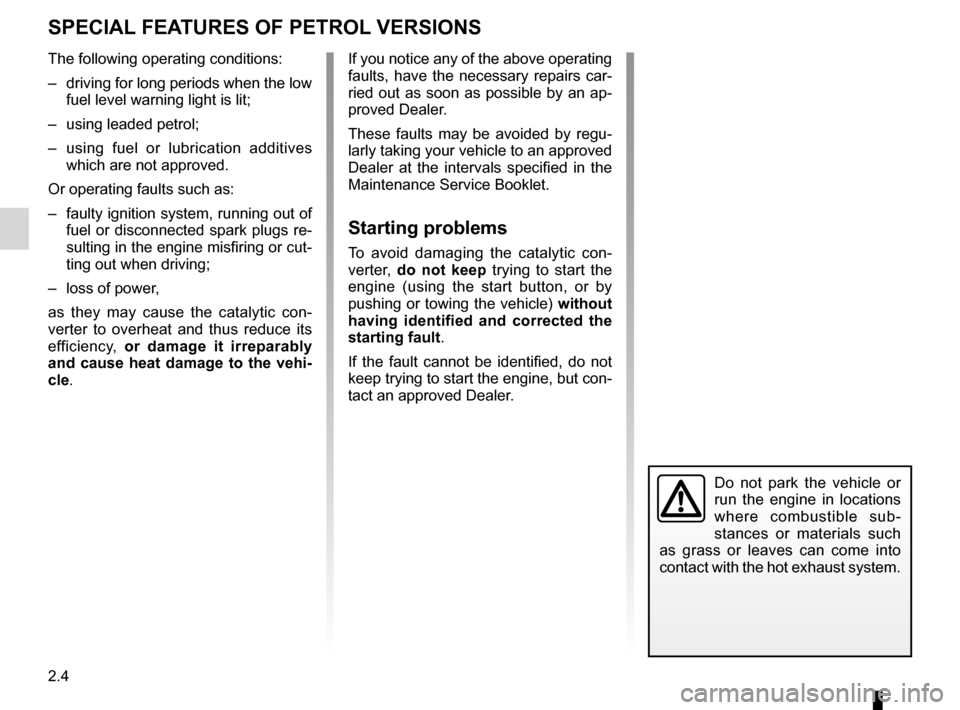
special features of petrol vehicles ........ (up to the end of the DU)
catalytic converter ................................. (up to the end of the DU)
driving ................................................... (up to the end of the DU)
catalytic converter ................................. (up to the end of the DU)
2.4
ENG_UD10553_1
Particularités des versions essence (X85 - B85 - C85 - S85 - K85 - R\
enault)
ENG_NU_865-6_E33_Renault_2
Special features of petrol versions
SPEcIAL FEA tURES oF PEtRoL VERSIoNS
The following operating conditions:
– driving for long periods when the low
fuel level warning light is lit;
– using leaded petrol;
– using fuel or lubrication additives
which are not approved.
Or operating faults such as:
– faulty ignition system, running out of
fuel or disconnected spark plugs re-
sulting in the engine misfiring or cut-
ting out when driving;
– loss of power,
as they may cause the catalytic con -
verter to overheat and thus reduce its
efficiency, or damage it irreparably
and cause heat damage to the vehi-
cle. If you notice any of the above operating
faults, have the necessary repairs car-
ried out as soon as possible by an ap-
proved Dealer.
These faults may be avoided by regu
-
larly taking your vehicle to an approved
Dealer at the intervals specified in the
Maintenance Service Booklet.
Starting problems
To avoid damaging the catalytic con -
verter, do not keep trying to start the
engine (using the start button, or by
pushing or towing the vehicle) without
having identified and corrected the
starting fault.
If the fault cannot be identified, do not
keep trying to start the engine, but con-
tact an approved Dealer.
Do not park the vehicle or
run the engine in locations
where combustible sub -
stances or materials such
as grass or leaves can come into
contact with the hot exhaust system.